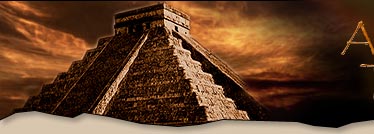Don't Forget to Register
To register, choose the category that best describes your role as a Sun Watcher:
Are you ready to embark on your journey through time to investigate the mysteries of our nearest star? This year's Sun-Earth Day Kit will help you do JUST THAT! In the kit you will find a variety of educational products designed to enhance your knowledge about how human beings from diverse cultures have viewed the Sun as a source of life and how we have used technology (past, present and future) in an ongoing effort to unravel its mysteries.
While supplies last, you can register to the right to receive your free Sun-Earth Day Kit! Additional kits for your classroom, science center, or museum, are available for $6.00 each through NASA CORE. International educators should contact the NASA CORE office for exact shipping to their area. Additionally, many NASA Educator Resource Centers will be offering workshops that will be supported with kits. For a center nearest you, visit the NASA Educator Resource Center Network.
Also, from this page you have the option to browse through the contents of the entire kit. Many of the resources can be downloaded and/or accessed on-line!

Sun-Earth Day Folder
This year's folder features a variety of solar related observatories and symbols thoughout time . We are providing you with a printable version of the folder.
Download Image(jpg - 3.08 Meg)»
The inside cover of the folder contains a student activity meeting the National Science Standard for "Habits of Mind", Grades 6-8. It is designed to help you make connections between events in your life and the seasons of the year. One major connection relates the concept of the seasons to past observations.
Download Activity»
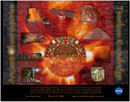
Ancient Observatories Timeless Knowledge Poster (SOHO)
This year's poster recognizes evidence of human efforts to understand the movement of the Sun and to build on what the ancient people have learned. It highlights the astronomy of Stonehenge, mysteries of Chaco Canyon and the Western U.S., more amazing sites in Central and South America, and modern observatories. The back of the poster contains several printable resources including a hands-on exercise for Grades 6-8: Finding Solar North.
Download Entire Poster(pdf - 721 KB)»
Download Front Only(pdf - 727 KB)»
Download Back Only(pdf - 726 KB)»

Traditions of the Sun Postcard (SECEF)
This postcard provides a short description of a website that allows one to have a virtual tour of Chaco Canyon. Watch the taped interviews of a National Park Service interpreter, Native American and NASA scientists. Learn about NASA research on the Sun and Native American solar practices.
Download Image(jpg - 195 KB)»
View Website»
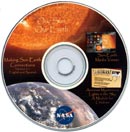
Our Sun Our Earth CD-ROM (SECEF)
This CD contains the following learning resources.
Making Sun-Earth Connections: This component contains a presentation for four different grade levels. Each presentation includes video clips, colorful graphics, and audio narration to help students understand the dynamics of the Sun, of the aurora, and of the turbulent space around Earth.
Sun-Earth Viewer: This component allows users with Flash 6.0 or higher to access live images of the Sun and aurora, illustrations, visualizations, and interviews with scientists.
View Online Version»
Auroras! Mysterious Lights in the Sky: This component Sky is an interactive book for Grades K-4
View Online Version»
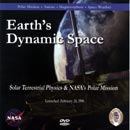
Earth's Dynamic Space: Solar-Terrestrial Physics & NASA's Polar Mission DVD (Polar)
This DVD, together with a supporting website, provides a thorough introduction to geospace physics. It can be viewed as an end-to-end product (one hour long) or split into individual segments (12-15 minutes each with an introduction) and tailored to lesson plans. The DVD tackles subjects such as the aurora, the magnetosphere and space weather, whilst highlighting the science discoveries of the Polar mission. This platform introduces the learner to key team members as well as the science principles. Dramatic visualizations are used to illustrate the complex principles that describe Earth's dynamic space. This DVD is intended for audiences ranging from a traditional classroom and after school clubs, to museums and science centers.
View Website»
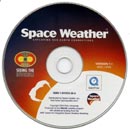
Space Weather CD-ROM (IMAGE)
This CD contains activities from the IMAGE/POETRY website. It also contains the standalone "Space Weather" educational module that is on display at many museums around the country.
View Website»
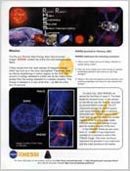
Discover the Solar Cycle Litho (RHESSI)
Take advantage of this math activity for middle and high school students to learn and "discover" the 11- year solar cycle through an investigation of solar x-ray flares. You can also find this activity featured in a one-half hour award-winning math and science program called "Having a Solar Blast" by NASA Connect. For additional copying or ordering information contact NASA CORE at 1-866-776-CORE or nasaco@leeca.org .
Download Activity(pdf - 725 KB)»
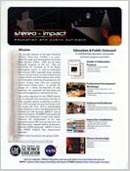
Mapping Magnetic Fields Litho ( STEREO/IMPACT)
Using bar magnets, classroom materials, and a compass, students will explore how bar magnets interact with one another and with other materials. Students will also use a compass, a bar magnet, paper, and pencil to make visible the lines of magnetic force (magnetic filed limes) around a bar magnet. For additional ordering information contact outreach@ssl.berkeley.edu .
Download Activity(pdf - 693 KB)»
View Website»
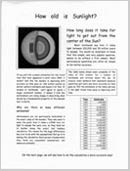
How old is Sunlight? Activity Sheet (IMAGE)
The light that comes to us from the sun takes about 8.5 minutes to reach us since it began its journey on the surface of the sun. However, the actual start of the journey is deep inside the sun in its thermonuclear core. This activity shows how to estimate the time this journey will take from the core. The answer is more than 20,000 years!!
Download Activity(pdf - 1.11 MB)»
View Website»
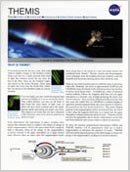
A Quest to Understand the Onset of Auroral Substorms Informational Flyer (THEMIS)
This flyer answers the questions, "What are auroral substorms?" and "How do they occur?" You will also find information on the network of schools across the country housing THEMIS magnetometers which teachers and students will use to monitor changes in Earth's magnetic field. Students from any of these schools will be able to act as space scientists using hands-on activities that support inquiry and that use THEMIS data posted on the web. A short history of substorms and a glossary are also included on the flyer. For additional ordering information contact outreach@ssl.berkeley.edu.
Download Flyer(pdf - 784 KB)»
View Website»
View School Network Information»

The Many Faces of the Sun: Multi-wavelength Solar Images over Time Poster (NSO)
Everyone has seen pictures of the Sun taken in visible light. Few have seen the many faces of the Sun in different kinds of light, that is, at wavelengths other than visible. In this poster from the National Science Foundation's National Solar Observatory, are five sets of images (Intensity, Magnetograms, H-alpha, Ultraviolet and X-ray) taken at five different wavelengths. Each of the five sets of images of the Sun was taken over a 14-day period (about half a solar rotation) between August 23 and September 5, 2000. Comparison of the images at different wavelengths provides a unique view of ever-changing solar features.
Download Poster(pdf - 929 KB)»

